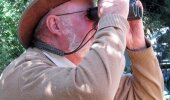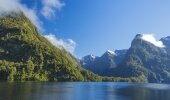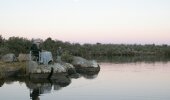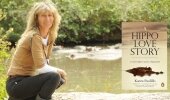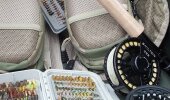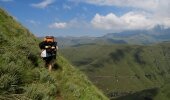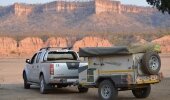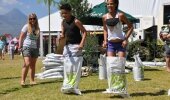Words & Photos: Greg Gearing
I recently spent a few days hiking in the Central Drakensberg area known as Injisuthi and was struck by the realisation of what a great privilege it is to live in KwaZulu-Natal. We are blessed with such an amazing variety of landscapes, which all offer a unique experience. Over the past three weekends, I have body surfed in the wonderful warm waters of the Indian Ocean, hiked in the cool air of the Drakensberg and paddled down the mighty Tugela River. And I could do all this within a 200 km radius of my home!
Photos by: Greg Gearing
The problem is that even though there is so much to do right on our doorstep, we still don’t make the most of it. There are a number of reasons for this, but I think often it’s because we get so caught up in the day-to-day madness of modern life that we don’t make the effort to get out and explore our surroundings. The fact that my latest hike in the Drakensberg was the first in two years was proof of this phenomenon.
A good friend of mine, Gavin Mathews, and I set out for what was meant to be a three-day hike in the remote area of the Drakensberg. The name Injisuthi, which means 'place of the well fed dog', was given to the area by the Zulus who, in the early days, claimed that there was so much game in the area that the dogs were always well fed. It’s not hard to understand why the game loved the area so much, simply put it is wild.
A couple of years earlier, Gavin and I had gone on a hike in the Berg totally unprepared and we starved. Eager not to repeat our former blunder, we stopped off in Estcourt to stock up with supplies before making our way up to Injisuthi. Judging by the weight of our backpacks we may have over compensated, but we weren’t going to complain.
Having negotiated the rather poor road to Injisuthi (there is a 30 km stretch from the main Loskop Road that is fairly narrow and has plenty of potholes) we arrived at the beautiful main campsite. Nestled far up into the Little Berg, it offers great camping and chalet facilities for those less inclined to sleep high in the mountains.
Owing to the limited amount of hiking we had done in the last couple of years, we had planned to do a moderate round trip, sleeping in two well-known caves; Marble Baths Cave and Grindstone Cave. The route would take us to the top of Little Berg, which boasts spectacular views of the escarpment. Some advice if you are planning to stay in a cave during a hike; make sure you book them in advance, especially in season. Unfortunately, we had not, which meant we would have to camp in a tent.
We eventually got going in the early afternoon. The hike up to Marble Baths is a relatively short trek of around 6 km, although with a full pack it still makes for a good work out. We began by meandering up the right-hand side of the Njesuthi River before crossing over. There's a cable that has been placed across the river to assist crossing when the river level is higher. For most of the walk we were in awe of the magnificent views of indigenous forests, which are fairly unique to the Injisuthi area. Halfway up to Marble Baths, we stopped in a ravine under the shade of some old yellowwood trees to enjoy a late lunch of fresh bread and chips.
After lunch, we continued up the valley until we rounded a corner and came upon the cascading tributaries that make up the Marble Baths. The river cuts its way through the sandstone and bedrock to create a number of crystal-clear pools and chutes. This is a fantastic spot to spend a day sunbathing and bum sliding. Marble Baths is situated close enough to the main campsite to make it a viable day hike option, but this also means it’s one of the more popular spots in the area.
We had hoped that we may get lucky and the cave would be free, but sadly it was taken. With the light fading, we set about finding a campsite for the evening. After exploring the surrounding bush for a short while, we stumbled across a clear patch. Once we had set up camp, we made our way to the pools for an evening swim/bath. There is nothing quite like the cool waters of the Drakensberg to refresh you after a day’s hike.
The beauty of hiking is that the simplest things become great. For example, a basic meal of couscous and viennas mixed in with a Tomato Cup a Soup tasted like a gourmet meal. Once we had polished off our delicious dinner we sat under a blanket of stars, shared a whiskey and cigar and became quite philosophical in the process.
The next morning we awoke to a clear, bright and sunny day. We spent most of the morning trying out the countless pools and bum slides until a hole in my underpants signalled that we needed to get going. The day began with us climbing steadily as we contoured our way up and into the next valley. The stunning views of the escarpment are extremely distracting and that coupled with the fact that the path is pretty overgrown meant we were soon lost. Having a good map with you while hiking in the Berg is essential, even if you think you know the area well enough, because a slight change in the weather or a wrong turn can get you completely disorientated. After much bush whacking through the thick indigenous forest, we eventually made it back to the stream and found the path once again.
Photos by: Greg Gearing
A quick snack
break was needed to re-energise and soak up our surroundings before we tackled the steepest section of the hike, which would take us out of the valley and up to the top of the Little Berg. It was rather tough work and Gavin was definitely feeling the strain because at one stage, he turned to me and asked, “Do you think this hike is tougher than the Comrades?” As tired as I was, I had to respect all those thousands of people who have put themselves through such pain to complete the gruelling marathon, so I politely replied, “No.”
Once we reached the top, we rewarded ourselves with a lunch of cheese, biscuits and biltong - a meal I am sure would motivate most people to climb a mountain. For most of the hike we had been out of cell phone reception and now, standing on top of the Little Berg, the messages started to come though. Unfortunately it was not all good news; Gavin received a message from his wife to say that four of his cattle had died of Red Water.
We had two options; either hike a little further and spend another night in the Berg, like we had originally planned, or push on and try to make it home later that evening. Being a farmer cattle is Gavin’s livelihood, so the decision was simple. We would try to get back home as soon as possible, to ensure no more cattle died. Fortunately, from this point on it was all downhill (although going downhill with a full pack is still tough) and we soon breezed past Grindstone Cave on our way to the main camp.
We arrived back at camp in the late afternoon with enough time to take one last dip in the cool mountain river before packing the bakkie and heading to the farm. Although the hike had been cut short, it was still a fantastic opportunity to get out and enjoy yet another wonderful area of our country and I felt as content as a well fed dog!
Need to know
• Booking of caves in advance is recommended.
• A good map of the area you are hiking is essential (these can be obtained from the reception of most of the Drakensberg Parks).
• Always pack warm clothes, even when hiking in summer, and wear comfortable and sturdy walking shoes or boots.
• Pack at least one day’s food rations extra.
• The best time to visit is April and May, although June through to September are also good months for hiking if you don't mind the cold.
• Remember to pack sunscreen, a hat and drinking water. Take binoculars if you plan to do a spot of twitching.
Did you know?
• The uKhahlamba/Drakensberg was the first site in South Africa to be recognised as both a Cultural and Natural World Heritage Site. When you go hiking in the Little Berg you’ll find out why.
• The Little Berg describes the foothills of the mighty Drakensberg - South Africa’s highest and most spectacular mountain range.
• The Kamberg Nature Reserve in the Little Berg is also home to superb rock paintings.
For more information on the caves and hikes in the Drakensberg, visit www.berg.co.za


